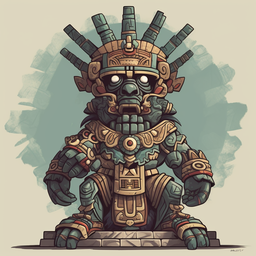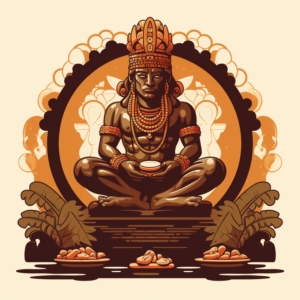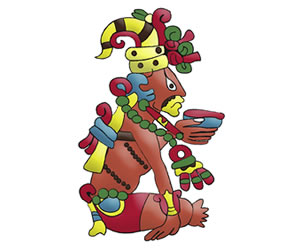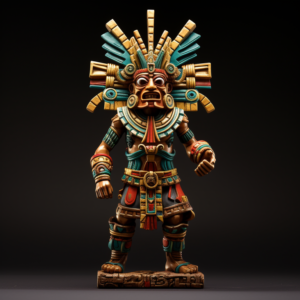While many Mesoamerican cultures had deities that were specific to their own societies, there were other gods that were worshipped widely across Mesoamerica. These gods tended to be responsible for the larger domains, including the sun, the afterlife, and the rain. One of the most important of these gods was Tlaloc, a chief god of the rain who was worshipped by a number of different Mesoamerica societies. Though never the king of the gods, he was a deity that spread across centuries and cultures to become one of the most important touchstones in the world of Mesoamerican mythology.
Description
The primary representation of Tlaloc in Aztec culture is of a humanoid figure. He tends to have a large head, large eyes, and fangs. This is the version of Tlaloc that is commonly identified from both carvings and statues, though some researchers claim that at least some of the more common images that have been identified as Tlaloc may belong to related to gods – including some that have been identified as his sisters.
Like many Mesoamerica gods, Tlaloc was capable of changing his shape. Unlike some of those other gods, there were no special way to identify one of these animals as Tlaloc. He was frequently seen as a heron, but could also be seen as any type of amphibian and sometimes even as a shellfish. His primary form, though, almost always seems to have been as a more humanoid god.
Symbols
There are quite a few Mesoamerican symbols associated with Tlaloc. The most important of those symbols, Mount Tlaloc, was also traditionally considered to be his home. In addition to this mountain, Tlaloc was symbolized by mountains in general as well as caves and springs – the places where water and mountains met.
Water was also an important symbol for Tlaloc. He was often represented by water, rain, and iconography related to storms. His role as master of water and rain also led to him being represented by the heron. Indeed, virtually any creature that lived in or on the water could be used as a representation of Tlaloc.
Since Tlaloc was ultimately connected to life-giving water, he was also represented by a number of plants. While he was often associated with rain, the major flower associated with him was the Mexican marigold. It was this plant that was most often used in major rituals associated with Tlaloc.
Powers & Abilities
Tlaloc had quite a few different powers, mostly owing from his role as a god of rain. In his primary office, Tlaloc had the ability to control water. This made him at once the deity in charge of life-giving rain and of storms, especially those that included thunder and lightning. Though other deities had offices that dealt with water, it is thought that Tlaloc was the ultimate deity in terms of water that could nourish and destroy.
This deity also had the power to change shapes, a feature that is common in many different Mesoamerica belief systems. Unlike some other gods, though, Tlaloc actually had multiple forms. He could turn into almost any kind of creature that dwelled in the water, including shellfish and herons.

Family
Like many Aztec deities, Tlaloc has a fairly well-defined family. He not only has at least two siblings, but also a wife and a son.
Tlaloc’s most prominent sibling is Chalchiuhtlicue, a goddess is who associated with fertility and groundwater. In some sources, she is also the father of at least one of his children. His older sister is Huixtocihuatl, a goddess that has dominion over salt and saltwater. His son, possibly by his younger sister, was Tecciztecatl – a god of the moon.
Tlaloc’s wife was the goddess Xochiquetzal, a goddess of youth, fertility, and female sexuality. Her relationship as his wife does not seem to have been as ritually important as his relationship with Chalchiuhtlicue, and there are no references to any important children that came from his relationship with Xochiquetzal.
Stature
While Tlaloc was never the chief of the gods in Aztec myth, he was perhaps one of the most widely recognized and important gods in ancient Mesoamerica. Given his position as a rain god, he was widely considered to be one of the more important gods in the Aztec pantheon and he was often also at once both feared and loved.
Tlaloc’s position is more important not for where he sat in the pantheon, but for how many different cultures worshipped him. He was considered a primary rain god across ancient Mexico, likely worshipped by the Maya and possibly even the Olmec under other names. This positions Tlaloc as a remarkably old god and thus one that helped to unite the various beliefs of various tribes and societies across the region.
Worship
Unlike many other Mesoamerica gods, we actually know quite a bit about the worship of Tlaloc. He was not only worshipped by the Aztecs but worshipped by societies across Mexico. We actually know that his worship predates Teotihuacan by quite some time.
Tlaloc was worshipped atop the Great Temple of Tenochtitlan in his own special shrine. We know that sacrificial hearts were offered here, hoping to gain Tlaloc’s favor for the harvest.
At Mount Tlaloc, the god was also worshipped with festivals and sacrifices. In order to gain his favor and secure a bountiful harvest, children would be dressed as Tlaloc and sacrificed in his name. Children were actually sacrificed to Tlaloc during several different festivals, most of which were based around the desire for a good harvest or for abundant rain.
Mexican marigolds, a symbol of Tlaloc, were often burned as incense in his honor during religious festivals. There is also evidence to suggest that Tlaloc was given sacrifices of jaguars – an incredibly important gift in Aztec culture, as jaguars were considered a very valuable animal. In fact, most sacrifices made to Tlaloc were highly valuable – even the children sacrificed to him were usually from higher social classes.






